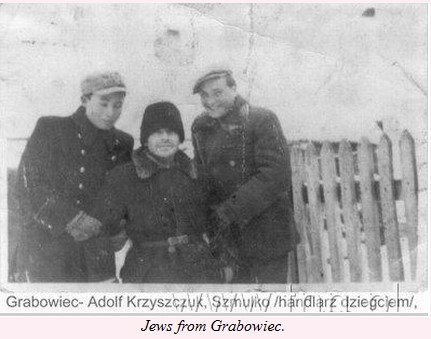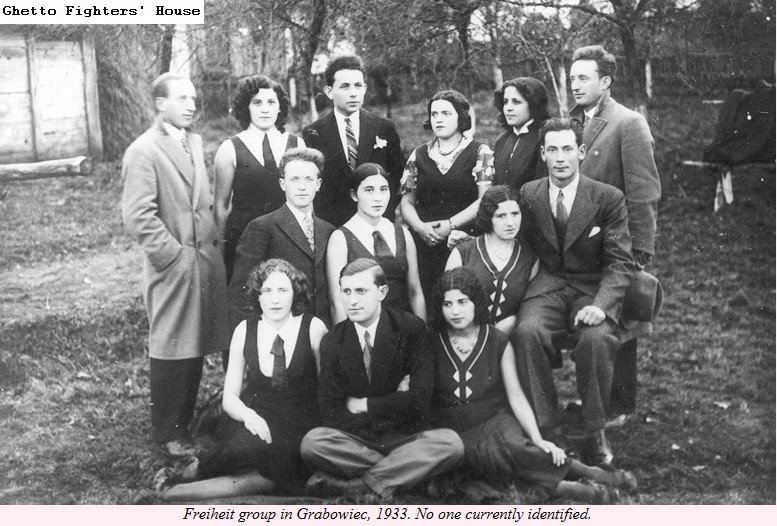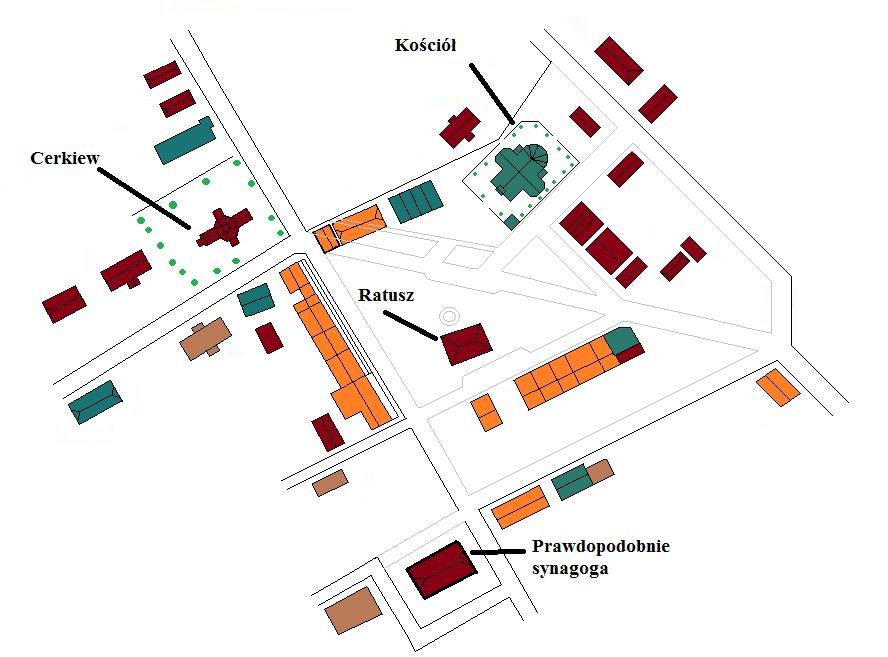Remember Jewish Grabowiec
Pronunciation: Grab-ov-yitz
HISTORY OF JEWISH GRABOWIEC
Grabowiec is a village in SE Poland with a population of around 922. It is 24 km. northeast of Zamosc
In 1630, twenty Jews lived in Grabowiec. Jewish inhabitants of Grabowiec are mentioned in the first half of the 17th century, and they played an important part in the development of local trade. In the years of decrees (1648-49), when the troops of Chmielnicki besieged the town, many of the Jews took part in its defense. Around 1720, the first Jewish cemetery was established in Grabowiec.
Expanded in 1772, the Jewish cemetery was in operation until the end of the 19th century on Wspólna Street. In 1891, a new cemetery (located on the north side of the road to Hrubieszów, in a ravine outside the town) was established and operated until 1942. Before 1716, a synagogue was built in Grabowiec, and before 1800 a Beit Midrash was established. In the 19th century a bath house, mikvah and prayer house existed. The prayer house had been burned down in 1887 but was rebuilt in 1891.
In 1765 only Jews lived on the main square. There were 13 Jewish houses and a little further from the Square -- an additional 19, behind which the gardens and buildings owned by Christian townsmen were located.
Following the town fires in 1814 and 1838, a total of 193 houses were burned down. A number of Jewish families moved to other towns, which caused a significant decrease in the number of Grabowiec residents. In 1860 roughly 1,000 Jews, 570 Catholics and less than 500 followers of the Orthodox Church lived there in 310 houses. Similar to a number of towns of comparable size and infrastructure in the region, the Christian population was engaged mostly in farming and crafts, while the Jewish population
conducted trade, liquor and wagon driving businesses. A few families dealt in grain or leased orchards.
In 1865, out of a total of 2,117 residents, Christian inhabitants (Catholics and Orthodoxies) comprised 1,113 people, and there were 1,000 Jewish residents, constituting 47% of the total population. In 1897 among 3,362 town residents, 1,717 were Jews and in 1904 there were 2,167 Jews, constituting almost half of the population. Grabowiec was a decidedly Chassidic town. There were 'stiebelech' of the Chassidim of Husiatin, Kock, Belz, Radzyn, and other courts. A prominent local figure was Rabbi Eliezer Ber, a pupil of Rabbi Simcha Bonem of Przysucha. Rabbi Ber was renowned as a brilliant preacher. Also noteworthy was Rabbi Hirsz Ber, the local leader of the Kock Chassidim.
The Jewish children attended the traditional cheders and Talmud Torah, and some of the boys went on to the Beit Midrash. There were several cheders, as well as a Jewish library, which was operated by Moszko-Kiwa Fink. Weekly market days were held, as well as six fairs a year.
The outbreak of the First World War brought with it a period of much distress and suffering for the Jews of Grabowiec. The Russian authorities accused them of aiding the Germans, and many of them were forced to leave their homes and move to towns within Russia. During the German and Austrian occupation (1915-1918) the old restrictions on Jewish public life were removed. A local committee was set up to help the needy. An association of young supporters of Zionism, called 'Hatikvah' (Hope) was established -- as well as a branch of the Bund. In 1917 the Zionists of Grabowiec opened a public library.
In the interwar period, six private houses of prayer operated in Grabowiec. Their owners were: Szaja Leszcz, S. Karimirski, S. Usiatymski, Josek Borensztejn, Moszek Lindenbojm, and Szulim Goldbaum. Those employed by the Jewish community of Grabowiec in the 1930s included Rabbi A. Szor; religious teacher H. Szysler, secretary J. Zyngier, mikva operator Ch. Szczupak, and shochets J. Erlich, Sz. Fajl, & L. Korenblum.
After WWI, Jewish merchants and craftsmen created a Provident Fund and a Cooperative Bank in 1927. 'Poalei Zion' (Workers of Zion) , 'Tseirei Zion' (Zionist Youth), 'Hamizrach' (Religious Zionists), 'Hapoel Hamizrachi' (Religious Zionist Workers), and 'Hechalutz' (The Pioneer - from 1930) groups were formed. Parallel to these were the Zionist youth groups: 'Dror' (Freiheit - Freedom), 'Beitar' (Revisionist Youth), and the Jewish Scouts, who had 120 members. Some of the young Zionists went to training farms, and
afterwards emigrated to Palestine. For the Zionist Congress in 1939, there were 392 votes from Grabowiec. The non-Zionist parties included the orthodox 'Agudat Israel', and the Bund -- most of whose members were artisans. A few Jewish youths were members of the Communist Party.
In 1933 the local Zionists set up a Hebrew elementary school called 'Tel-Chaim' (Hill of Life - after Chaim Arlosoroff). In 1938 another school, 'Yavneh', was opened by Hamizrachi. The Hebrew schools also held evening classes in Hebrew and Bible Studies for working youth. Two public libraries, affiliated to 'Poalei Zion' and the Bund, and embracing drama and literary activities, were opened in the town. The Bund library was closed by the authorities for alleged distribution of Communist propaganda.
Jewish communities near Grabowiec included: Horyszow (unknown Jewish population), Miaczyn (50 Jews), Skierbieszow (150 Jews) and Uchanie (1,161 Jews).
GRABOWIEC DURING THE HOLOCAUST
Before the outbreak of WWII, 2,356 Jews lived in Grabowiec. They were mostly engaged in commerce, including gold procurement and agricultural produce. A synagogue and several prayer houses were in the village. At the beginning of October of 1939 some 200 Jews attached themselves to the Red Army units withdrawing to the Soviet Zone. Immediately afterwards the Germans entered Grabowiec. Jews were quickly and violently rounded up for slave labor. After a while the Germans evicted the Jews from their houses and concentrated them in a ghetto. Some 2,000 Jews were crowded into a few streets, a few families to each apartment. The ghetto was not fenced in, and its inmates were able to leave it and obtain food from the local peasants in exchange for the few belongings still in their possession.
The Germans set up a labor camp 10 km. from Grabowiec and employed workers from there and nearby towns. They appointed a Judenrat in the town, whose task it was to provide Jews for slave labor and to obey German orders. On September 20th, 1939, a unit of the Red Army entered the town, but withdrew after a fortnight and was replaced by German troops, in accordance with the Soviet-German agreement.
In March 1941 there were 1,435 Jews in Grabowiec. Crowding in the ghetto grew even worse when Jewish refugees from other places were brought there. In November 1941, 50 Jews from Krakow arrived. During the autumn of 1941, the situation deteriorated even more when the ghetto was fenced in and exit from it forbidden. In May 1942, 600 Jews from nearby towns were crammed into the ghetto. The total number of inmates in the Grabowiec Ghetto at this point was 2,050.
In the winter of 1941 and 1942 furs, gloves, fur hats and gold were confiscated from local Jews. On May 21, 1942 the German troops shot 33 Jews. On June 8th, 1942, in the early morning, S.S. troops, aided by Polish police, dragged the Jews from their houses and assembled them in the market square. Old people, women and children were piled onto carts requisitioned from Polish peasants for this purpose, while the men marched on foot. All of them were taken to the station at Miaczyn, some 10 kilometers away, where they were sorted. Some scores of ill people were killed on the spot; about 800 Jews fit for work were sent back to Grabowiec at the request of their Nazi employers, while the remainder -- some 1,200 souls -- were dispatched in wagons to the extermination camp at Sobibor. In October 1942, the remaining Jews in Grabowiec were likewise sent to their deaths there. This October transport is described by eyewitness Dr. Michael Temchin, who also was on the transport but was able to escape one of the train cars destined for Sobibor, in his book "The Witch Doctor."
In 1942-1944 groups of youngsters who had fled in the autumn of 1939 to eastern Poland joined partisan units operating in the area. Among the combatants from Grabowiec were Dawid Ehrlich, his uncle, Szyfra and Chana Szysler, Malka Rub, and Simcha Estik (Astyk). Most of the Jews who had fled to the Soviet Union in the autumn of 1939 survived. A few Jewish families from Grabowiec survived by hiding in the forest and among the Christian population.
The synagogue in Grabowiec was destroyed in 1942 by the Germans. No traces of it remain, nor are there any representations of how it appeared. At the new Jewish cemetery, a mass grave of 30 Jewish victims of the Holocaust exists. It is unmarked. Some matzeva comprise a stair-case located at 700 Lecia street, Grabowiec.
Please donate to the Jewish Records Index - Poland translation of Grabowiec records. Without your support, we can't appropriately memorialize our families.
Please review the site content below. Zachor - We Remember.
------------------------------------------------------------------------
[Surnames and Researchers] [Grabowiec Yizkor Book (Hebrew)]
[Memorial Book of Grabowiec (readable online)]
------------------------------------------------------------------------
Return to Lublin IndexLINKS
Join the Grabowiec group on Facebook!
Village of Grabowiec:
Book: The Witch Doctor
Dr. Michael Temchin Collection
Pinkas Hakehillot Polin: Grabowiec
Virtual Shtetl - Grabowiec
Yizkor Book Wojslawice near Grabowiec
Families of Grabowiec:
Bojm family
Lazer/Lazar family
Rajs family
Rabbis of Grabowiec:
Rafael Kligier
Eliezer Markowicz
Eliezer Hartztark
Chaim Hochgelernter
Menachem Mendel
Shalom Josef of Jozefow
Eliezar Shor
Shalom Tzvi Goldbaum
Gabriel Ze'ev Esselke, 1909
Hersh Lejb Szysler
Aharon Yosef Shor (died 1938)
Rabbis of Wojslawice:
Dawid London
Yitzchak Citrinbojm
Shlomo Hochler
Notable Residents of Grabowiec:
Itshe Biderman
Avraham Eines
Fiszel Lazer
Notable Descendants of Grabowiec:
Heddy Honigmann
Survivors of Grabowiec:
Chaim Bacher (Becker?)
Chaim Pinchas Blaff
Yosef Boim
Sara Bojm Rosenfeld
Golda Cukier
Eliezar Ennis (Ejnes)
Bina Fenig
Benzion Fink
Mordechai Fink
Shifra Fishman Schiessler
Natalie Fruchter
Avish Goldfarb
Leibus Golomb
Yeshaya Hiter
Israel Hostik
Tselinah Kotek
Tuvia Kreitman
Efraim Lerner
Zelda Miler Dobzhinski
Avraham Nadel/Nudel
Yosef Nudel
Leah Pergament
Chaja Papier Rajs
Hershel Rajs
Lillian Rajs Gewirtzman
Yaakov Reichman
Yosef Roth
Lea Schreit
Chana Silberszweig
Avraham Starker
Ita Starker
Jack Sukiennik
Eliyahu Torer
Moshe Wald
Sara Zatz
Survivors of Wojslawice:
Estera Dafner Tenenbaum
David Eines
Leibel Eines
Shabtai Eines
Szandla Fierman Wagenfeld
Mirla Gutmark
Rachel Gertz
Avraham Hendler
Rabbi Shlomo Hochler
Fajwel Hochlerer
Mordechai Kalmanowitz
Shimon Kanc
Aleksander Kasha
Israel Kelner
Moshe Kleinminc
Rivka Luden
Shlomo Ofir
Moshe Rab
Yitzchak Irving Raab (Rab)
Lejb Rejs
Luba Schmaltz
Moshe Strassberger
Yakov Zisman (Sussman)
Genealogy:
Jewish Records Indexing Poland - Grabowiec
Jewish Vital Records in the Polish State Archives
Jewish Records Indexing Poland - Wojslawice
Remember Your Family:
Central Judaica Database - Museum of History of Polish Jews
Grandchildren of Holocaust Survivors on Facebook
Guide to the YIVO Archives
Holocaust News/Events from Generations of the Shoah Int'l
Holocaust Survivors and Victims Database
JewishGen Family Finder
JewishGen Holocaust Database
JRI-Poland: Search for Your Family
Museum of History of Polish Jews Introduction
Yad Vashem: Search for Your Family
Yad Vashem: Submit Names of Your Family Members
Yad Vashem Requests Photos of Shoah Survivors and Families
CONTACTS
U.S.: LublinJewish@gmail.com
This is a town plot from someone in Grabowiec who researched the landmarks. “Prawdopodobnie synagoga” is where the synagogue may have been located. This location is the corner of Gorna Street and Wspolna Street.








